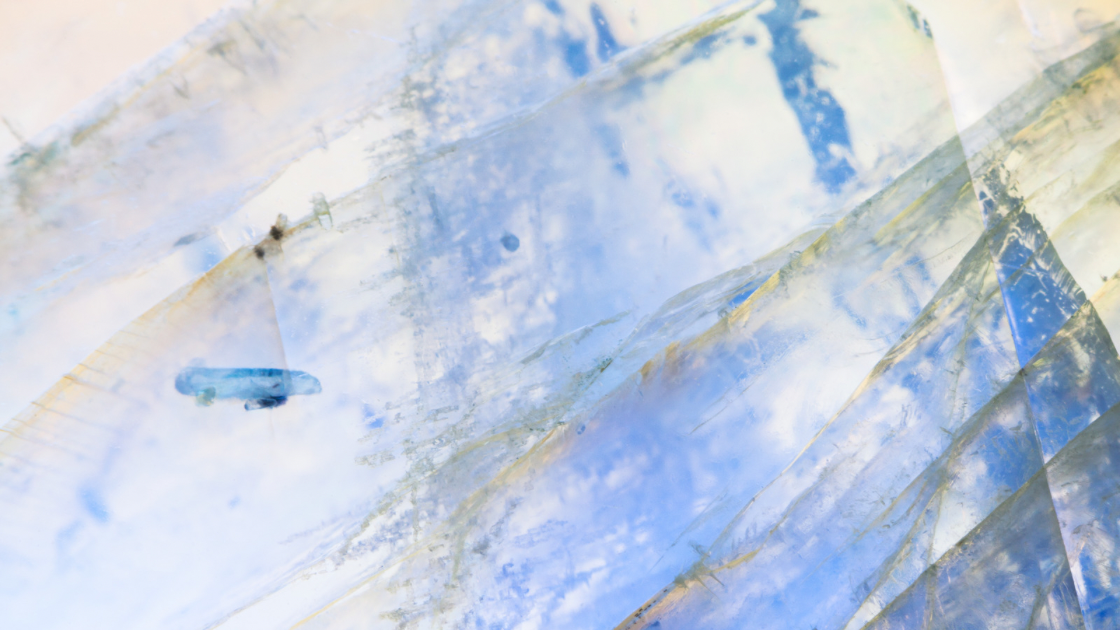Moonstone is often associated with intuition, feminine energy, and the magic of the moon
What is Moonstone?
Moonstone, known for its ethereal and otherworldly appearance, is a popular choice in jewelry and ornamentation. Its unique sheen, known as adularescence, gives it a mystical glow, resembling moonlight.
The stone, a sodium potassium aluminum silicate, belongs to the feldspar group.

Meaning and Symbolism of Moonstone
Moonstone is often associated with mystery, femininity, and intuition. It is considered a stone of inner growth and strength, soothing emotional instability and stress.

A Stone for Intuition
Moonstone is believed to bring calmness and emotional stability, making it an ideal companion for those seeking a sense of tranquility and balance. It’s particularly revered by those who wish to connect with their inner selves and harness their intuition.
Moonstone is associated with the zodiac signs Cancer, Libra, and Scorpio. It is believed to enhance intuition, promote inspiration, and bring success in love and business matters.
In energy healing, moonstone is considered to be aligned with the crown chakra, encouraging spiritual insight and introspection.
moonstone at a Glance
Colors
Ranges from colorless to white, grey, brown, yellow, orange, green, or pink.
Luster
Pearly to vitreous (glassy).
Transparency
From transparent to translucent.
Chemical Composition
Primarily KAlSi₃O₈, (Na,Ca)Al₁₋₂Si₃₋₂O₈, often with a blend of other elements.
Healing Properties of Moonstone
Moonstone is often sought for its calming and soothing qualities, believed to help stabilize emotions and provide clarity. It’s also associated with enhancing creativity, compassion, and endurance.
Moonstone is thought to be especially beneficial for women, aiding in the regulation of menstrual cycles and balancing hormonal systems. It’s also seen as a symbol of fertility and sensuality.
While the healing properties of moonstone are cherished in various cultures, these beliefs are rooted in metaphysical traditions and are not scientifically proven.

Historical Significance and Uses of Moonstone
Moonstone has been admired for millennia, with its ethereal appearance captivating various cultures.
- Ancient Uses: Moonstone has been used in jewelry and as a talisman since ancient times, believed to bring good fortune.
- Art Nouveau Era: Moonstone experienced a resurgence in popularity during the Art Nouveau period, where it was featured in many elegant designs.
- Cultural Significance: In India, moonstone is considered a sacred stone, often displayed in temples and used in jewelry. It’s also a traditional wedding gift.
- Influence in Literature: Moonstone has been a subject of fascination in literature, often symbolizing mystery and hidden truths.
- Lunar Connections: The stone’s association with the moon has made it a favorite among those who practice moon rituals or have an affinity for lunar symbolism.
Moonstone has been revered not just for its beauty but also for its supposed metaphysical and healing properties.
How to Identify Moonstone
Moonstone is characterized by its unique adularescence, a glowing sheen that resembles moonlight. The best specimens show a blue or rainbow sheen against a light body color.
How to Pick Out Moonstone
When selecting moonstone, look for stones with a high degree of transparency and a strong blue or rainbow sheen. The value of moonstone can vary greatly, with the finest quality pieces displaying a deep, clear blue sheen and minimal inclusions.

Approved by Naturalist’s Guide
Rock Identifier App
Use image recognition to identify stones, crystals, and gemstones.
Uses for Moonstone
Apart from its widespread use in jewelry, moonstone is also used in decorative objects and occasionally in crystal healing practices. Its mesmerizing appearance makes it a versatile and popular gemstone.
Composition and Formation of Moonstone
Moonstone is composed of alternating layers of orthoclase and albite, which scatter light and cause its characteristic sheen. It forms in igneous and metamorphic rocks and is commonly found in Sri Lanka, India, and Madagascar.
How to Care for Moonstone
Moonstone requires gentle care to maintain its beauty. It should be cleaned with mild soap and water and stored separately to prevent scratches. Avoid exposing moonstone to harsh chemicals or extreme temperatures.
Moonstone can be cleansed with sage and recharged in both moon and sunlight.
Frequently Asked Questions
What does Moonstone symbolize?
Moonstone is often associated with intuition, feminine energy, and the magic of the
moon.
What is Moonstone good for?
It is believed to promote calmness, emotional balance, and enhance intuition and creativity.
How to clean Moonstone?
Simple soapy water and a soft cloth will do; just ensure it’s kept away from harsh chemicals.
Is Moonstone rare?
Some varieties of moonstone, like the blue sheen moonstone, are considered rare and highly valued.
Can you wear Moonstone every day?
Yes, but it should be worn with care as it’s not as hard as some other gemstones.








